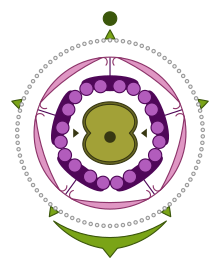Asteraceae
Their common primary characteristic is compound flower heads, technically known as capitula, consisting of sometimes hundreds of tiny individual florets enclosed by a whorl of protective involucral bracts.The oldest known fossils are pollen grains from the Late Cretaceous (Campanian to Maastrichtian) of Antarctica, dated to c. 76–66 million years ago (mya).Asteraceae species are generally easy to distinguish from other plants because of their unique inflorescence and other shared characteristics, such as the joined anthers of the stamens.[7] Nonetheless, determining genera and species of some groups such as Hieracium is notoriously difficult (see "damned yellow composite" for example).The word aster means "star" in Greek, referring to the appearance of most family members as a "celestial body with rays".[15] The individual florets in a head consist, developmentally, of five fused petals (rarely four); instead of sepals, they have threadlike, hairy, or bristly structures,[17] known collectively as a pappus, (plural pappi).The pappi provide a parachute-like structure to help the seed travel from its point of origin to a more hospitable site.The capitulum is a contracted raceme composed of numerous individual sessile flowers, called florets, all sharing the same receptacle.The phyllaries can be free or fused, and arranged in one to many rows, overlapping like the tiles of a roof (imbricate) or not (this variation is important in identification of tribes and genera).The presence or absence of these bracts, their distribution on the receptacle, and their size and shape are all important diagnostic characteristics for genera and tribes.Ray florets are always highly zygomorphic and are characterised by the presence of a ligule, a strap-shaped structure on the edge of the corolla tube consisting of fused petals.The calyx of the florets may be absent, but when present is always modified into a pappus of two or more teeth, scales or bristles and this is often involved in the dispersion of the seeds.[7] The pollen of composites is typically echinolophate, a morphological term meaning "with elaborate systems of ridges and spines dispersed around and between the apertures.They produce iso/chlorogenic acid, sesquiterpene lactones, pentacyclic triterpene alcohols, various alkaloids, acetylenes (cyclic, aromatic, with vinyl end groups), tannins.The phylogenetic tree of subfamilies presented below is based on Panero & Funk (2002)[26] updated in 2014,[27] and now also includes the monotypic Famatinanthoideae.[citation needed] The four subfamilies Asteroideae, Cichorioideae, Carduoideae and Mutisioideae contain 99% of the species diversity of the whole family (approximately 70%, 14%, 11% and 3% respectively).[citation needed] Because of the morphological complexity exhibited by this family, agreeing on generic circumscriptions has often been difficult for taxonomists.[7] The oldest known fossils of members of Asteraceae are pollen grains from the Late Cretaceous of Antarctica, dated to ~76–66 mya (Campanian to Maastrichtian) and assigned to the extant genus Dasyphyllum.[1] It is not known whether the precise cause of their great success was the development of the highly specialised capitulum, their ability to store energy as fructans (mainly inulin), which is an advantage in relatively dry zones, or some combination of these and possibly other factors.[30] The largest proportion of the species occur in the arid and semi-arid regions of subtropical and lower temperate latitudes.Epizoochory is another common method, in which the dispersal unit, a single cypsela (e.g. Bidens) or entire capitulum (e.g. Arctium) has hooks, spines or some structure to attach to the fur or plumage (or even clothes, as in the photo) of an animal just to fall off later far from its mother plant.[17] Asteraceae is an economically important family, providing products such as cooking oils, leaf vegetables like lettuce, sunflower seeds, artichokes, sweetening agents, coffee substitutes and herbal teas.Several genera are of horticultural importance, including pot marigold (Calendula officinalis), Echinacea (coneflowers), various daisies, fleabane, chrysanthemums, dahlias, zinnias, and heleniums.[42] Commercially important plants in Asteraceae include the food crops Lactuca sativa (lettuce), Cichorium (chicory), Cynara scolymus (globe artichoke), Helianthus annuus (sunflower), Smallanthus sonchifolius (yacón), Carthamus tinctorius (safflower) and Helianthus tuberosus (Jerusalem artichoke).[23] Members of the family are also commonly featured in medical and phytochemical journals because the sesquiterpene lactone compounds contained within them are an important cause of allergic contact dermatitis.French Marigold (Tagetes patula) is common in commercial poultry feeds and its oil is extracted for uses in cola and the cigarette industry.[citation needed] Centaurea (knapweed), Helianthus annuus (domestic sunflower), and some species of Solidago (goldenrod) are major "honey plants" for beekeepers.

1 – style with stigmas
2 – anthers
3 – corolla ( petals ); typically, in the ray flower, three petals are joined to form a strap (in other species, five petals can fuse to form a ligule )
4 – reduced calyx
4’ – Carduus acanthoides (left shaded circle): pappus : in many Asteraceae species, the calyx develops as a fibrous or bristly pappus
5 – inferior ovary : fused ovary consisting of two carpels , containing one abaxial ovule ( basal placentation ).




AstraeaceaePreꞒCampanianScientific classificationPlantaeTracheophytesAngiospermsEudicotsAsteridsAsteralesBercht.J.PreslType genusAsteroideaeLindl.BarnadesioideaeBremerCarduoideaeCichorioideaeChevall.CorymbioideaePaneroV.A.FunkFamatinanthoideaeGochnatioideaeGymnarrhenoideaeHecastocleidoideaeMutisioideaePertyoideaeStifftioideaeVernonioideaeWunderlichioideaeDiversity1,911 generaSynonymsGisekeMartinovSch.Bip.BurnettBurmeist.familyflowering plantsOrchidaceaeextantherbaceous plantsannualbiennialperennialshrubstropical regionshot desertsemi-desert climatesAntarcticaflower headscapitulafloretsLate CretaceousMaastrichtianmillion years agocrown groupSantonianConiacianinvasiveLachanodes arboreainflorescencestamensdamned yellow compositetaprootscaudicesrhizomesalternateoppositewhorledsimpleconduplicaterevoluteentiretoothedHecastocleis shockleyiCorymbiumGundeliaGymnarrhena micranthaBidens tortapollinatorsradially symmetriccelestial bodybractsphyllariesinvolucrepetalssepalspappusseed dispersaldandelionLeucanthemum vulgarestigmasanthersinferior ovarycarpelsabaxialbasal placentationcorollavestigialbilaterally symmetricCarduusloculeDelairea odoratapseudanthiumcapitulumracemesessileflowersreceptacleHelichrysumactinomorphiczygomorphicconnatepistilplacentationacheneHelianthusmorphologyendospermmorphologicalinulinchlorogenic acid